Recipes for Recognition: An Anthropological Study of Digital Attribution Ethics
Field notes from the frontlines of digital ownership disputes
There is a popular edict in creative writing which says “show don't tell”. This technique is about conveying story through sensory details and actions rather than explicit exposition. By presenting vivid imagery instead of explanations, writers create an immersive world for the reader to experience.
But when applied beyond fiction writing, particularly in public relations and crisis management, this principle transforms. It's here where show-don't-tell evolves into something more calculated – it no longer functions as a mere creative technique but mutates into a medium (and message) separate from the explicit statement. It creates a shadow narrative that runs parallel to the stated one, with a crucial advantage: this secondary story unfolds primarily in the minds of the audience, requiring no additional effort from the communicator.
This shadow narrative replicates organically through online discourse, occasionally requiring only the gentlest nudge in a preferred direction. Such interventions are rarely necessary as public attention typically moves on before any deeper analysis takes place. In this space between what is explicitly stated and what is implicitly suggested, we find a rich territory for examining how digital communities construct and defend their ethical frameworks—often without directly acknowledging them.
A Case Study in Digital Attribution
When Australian recipe developer and cookbook author Nagi Maehashi of RecipeTin Eats accused social media baker Brooke Bellamy of plagiarising recipes1 in her bestselling cookbook Bake with Brooki she was doing more than merely stirring the pot2. What Nagi did was reveal how different digital communities develop distinct understandings of creativity, ownership, and attribution.
I'm not here to determine who copied whom. Plagiarism in creative communities like cooking is difficult to prove and even more difficult to litigate. This case will ultimately be decided by public opinion (all while providing grist for the drama mill). What this article aims to examine is something more nuanced: the collision between two digital cultures that appear similar on the surface but operate with distinctly different ethical frameworks. It's in these slight differences—between recipe developers and social media influencers, between testing-focused and aesthetic-focused content creation—that we find revealing orientations toward originality, attribution, and creative ownership.
The Evidence at Hand
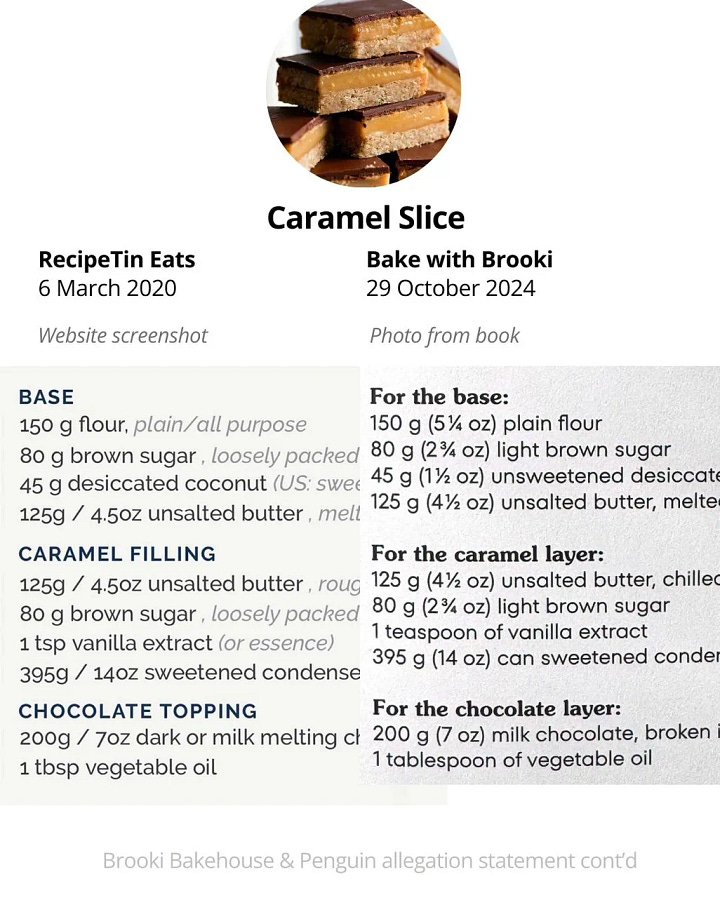
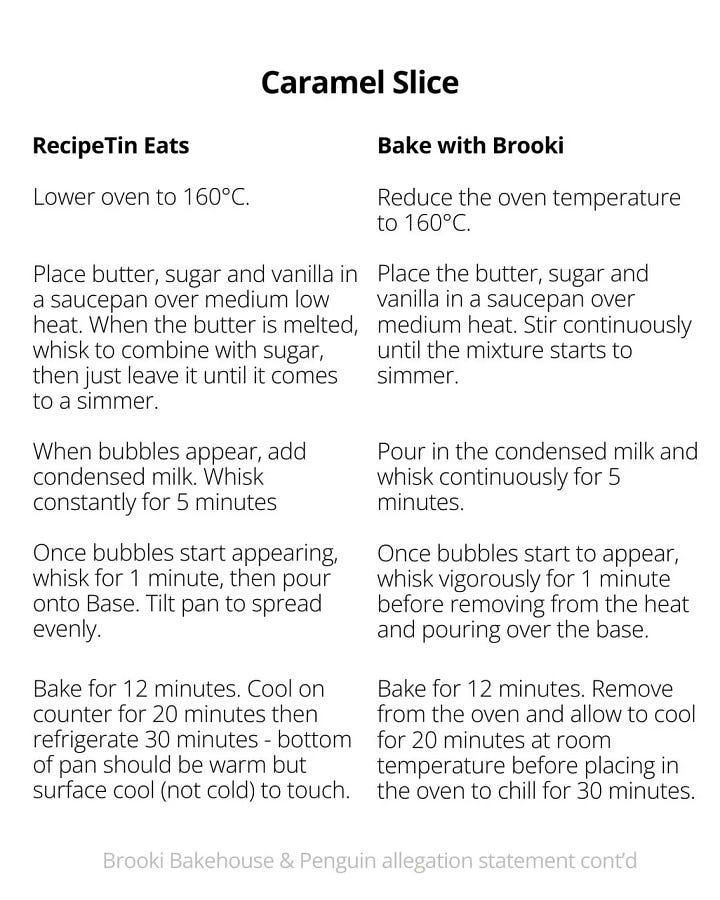
This controversy centres around strikingly similar caramel slice and baklava recipes with identical measurements and matching instructions. In her blog post detailing the allegations, Maehashi writes:
While recipes can resemble one another, because there are only so many ways some recipes can be made, the precision and detail in the similarities in this case are, in my opinion, far too strong to be a co-incidence (sic).
My Caramel Slice recipe is special because it is made using caramel as the base (I mean, the name..!) rather than golden syrup which is the typical recipe (gives it a metallic flavour, I swear!). I can tell you the exact moment in my life that triggered the creation of this recipe – how and why it came to be, and what I tried before deciding that I had figured out The One.
Within 24 hours, Bellamy responded with an Instagram story where she writes:
In light of the recent allegations made against me by Recipetin Eats for plagiarising two of her recipes in my cookbook Bake With Brooki (caramel slice and baklava), I would like to provide the below statement.
I did not plagiarise any recipes in my book which consists of 100 recipes I have created over many years, since falling in love with baking as a child and growing up baking with my mum in our home kitchen.
In 2016, I opened my first bakery. I have been creating my recipes and selling them commercially since October 2016 - as shown in the next slide and as was communicated at the first point of contact I received.
On March 2020, Recipetin Eats published a recipe for caramel slice. It uses the same ingredients as my recipe, which I have been making and selling since four years prior.
I immediately offered to remove both recipes from future reprints to prevent further aggravation, which was communicated to Nagi swiftly through discussions.
I have great respect for Nagi and what she has done in recent years for cooks, content creators and cookbooks in Australia - especially as a fellow female entrepreneur.
Recipe development in today's world is enveloped in inspiration from other cooks, cookbook authors, food bloggers and content creators. This willingness to share recipes and build on what has come before is what I love so much about baking and sharing recipes - the community that surrounds it.
I stand by my love for baking, my recipes, and the joy this book has brought so many home bakers around the world eager to try recreating my recipes from inside their homes.
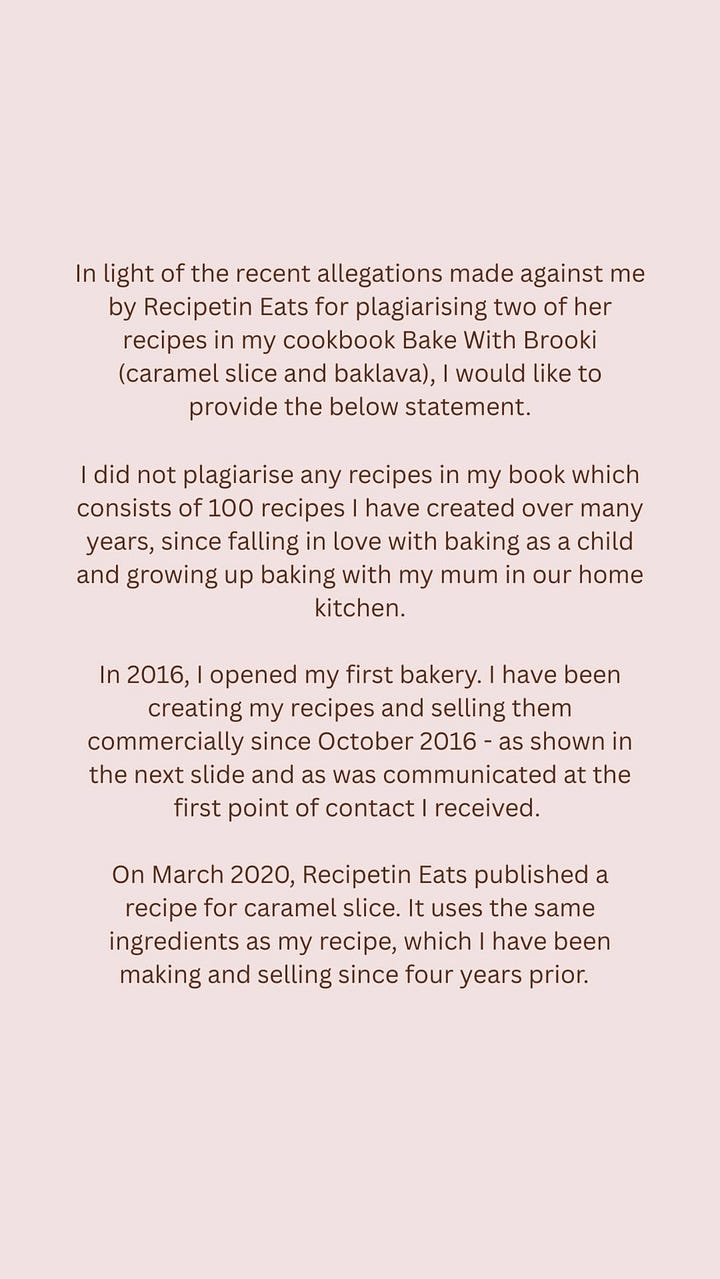
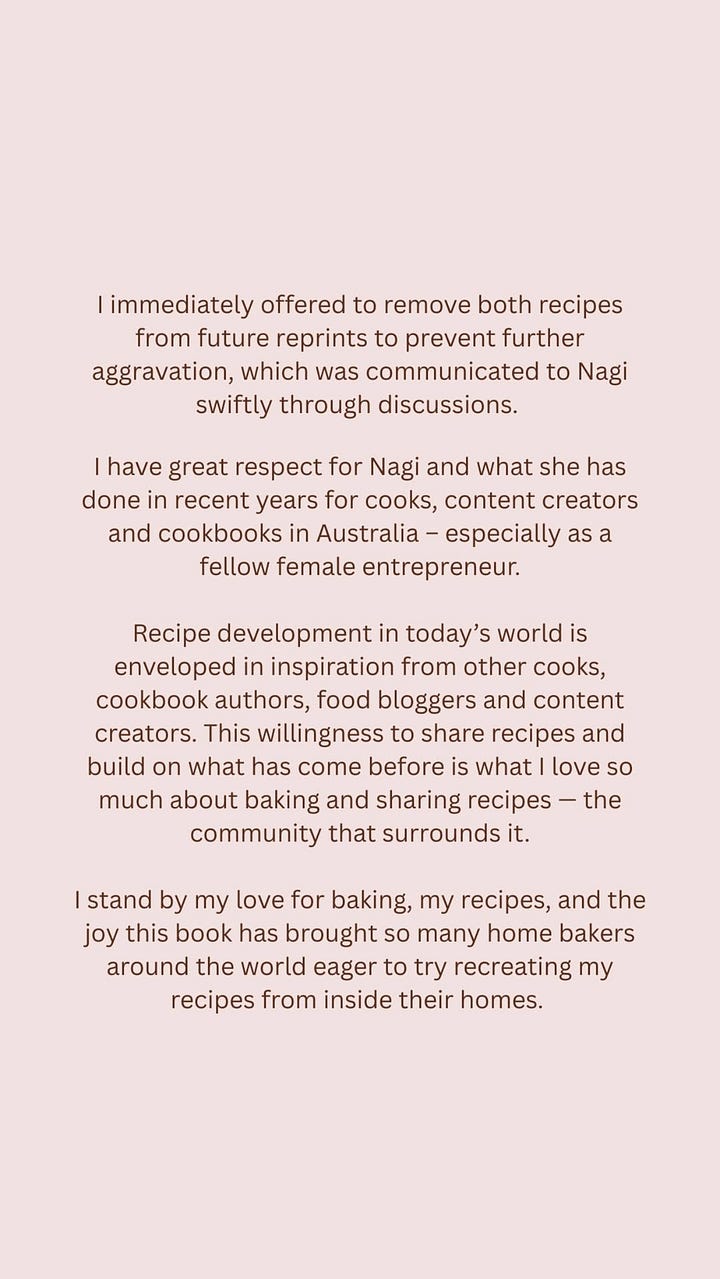
Bellamy's response to the allegations wasn't just defending her recipes – she was speaking the language of her community, where personal narrative often carries more weight than procedural documentation. Meanwhile, Maehashi's meticulous documentation of her recipe development process reflects the values of her community – where rigorous testing and explanation of the behind-the-scenes trial-and-error process form the foundation of credibility.
The question isn't simply "Did she copy?" but rather: "Are we even speaking the same cultural language when we talk about originality?"
Two Digital Cultures: Recipe Development vs Social Media Influence
At the heart of this dispute lies not just potentially copied recipes, but a collision between two distinct digital cultures with fundamentally different value systems, professional practices, and orientations toward content.
The Recipe Development Culture
Recipe developers like Nagi Maehashi operate within a community that places exceptional value on rigorous testing, meticulous documentation, and technical precision. This culture emerged from professional food writing but has expanded through blogs and recipe content across platforms. The development process typically involves:
Multiple testing iterations to perfect measurements, cooking times and techniques
Documented workflow from concept to final version
Detailed explanatory text providing context and methodology
Precise attribution when building upon another's work
A focus on the functional reliability of the recipe
When Maehashi writes “I can tell you the exact moment in my life that triggered the creation of this recipe – how and why it came to be, and what I tried before deciding that I had figured out The One”, she's not merely telling a story – she's establishing her technical authority through a narrative of process and refinement.
For recipe developers, the lineage of a recipe – where it originated, how it was adapted – is part of its core value proposition. Attribution isn't just ethical practice; it's essential context that enriches the recipe's story.
The Foodie Influencer Culture
By contrast, social media influencers like Brooke Bellamy operate in a digital culture where personal narrative, aesthetic appeal, and lifestyle aspiration are the primary currencies. It's worth noting that Bellamy does operate three brick-and-mortar bakeries (Brooki Bakehouse) in Brisbane, but her primary identity in digital spaces aligns more with influencer culture. Her communication platforms prioritise visual impact and shareability over detailed long-form content.
Visual presentation often takes precedence over technical precision
Personal connection with audience drives engagement
Content is oriented around personality and lifestyle
Products emerge from personal narratives rather than technical processes
Attribution practices are less codified and often more casual
Where recipe developers focus on the detailed history of recipe development, influencers often frame content through personal experience narratives. Bellamy's emphasis isn't on the technical development process but on the emotional journey: “falling in love with baking as a child and growing up baking with my mum in our home kitchen”.
The influencer economy rewards the appearance of effortless mastery over documented expertise. This isn't necessarily disingenuous – it's simply a different orientation toward content and audience relationship.
Digital Architecture and Its Influence
The platforms that host these communities further shape their distinct cultures. Recipe blogs incentivise detailed process documentation and search-optimised methodology. In contrast, visual platforms like Instagram and TikTok reward aesthetic consistency and personal narrative over technical detail.
This architectural difference shapes both how content is created and consumed. Recipe developers write with an assumption that readers are seeking detailed instruction. Influencers create with the understanding that their audience is there for a parasocial relationship facilitated through aspirational content.
Economics of Attribution
Perhaps most revealing are the economic models that underpin these cultures. Recipe developers typically monetise through:
Advertising on detailed recipe posts
Cookbook sales based on technical expertise
Brand partnerships highlighting their testing expertise
Influencers monetise through:
Sponsorships based on their personal brand
Product lines leveraging their aesthetic
Merchandise that embodies their lifestyle proposition
This last point deserves further examination. For both Bellamy and the wildly successful American cookie chain Crumbl, the primary currency isn't the detailed technical development process behind each recipe, but the visual and experiential qualities that make their products shareable.


Crumbl, like Brooki Bakehouse, has mastered the art of turning baked goods into social media phenomena through carefully curated aesthetics, rotating menus that create FOMO, and distinctive packaging designed to be photographed. Their pink boxes are as much a part of their brand identity as their oversized cookies. The aesthetic-forward approach has helped Crumbl grow to over 600 locations in just five years, demonstrating how the influencer ethos can successfully translate to brick-and-mortar retail sales.


Both Crumbl and Brooki Bakehouse create products primarily designed to be consumed digitally. Whether the cookies are "good" is almost secondary—they aren't selling baked goods for everyday consumption so much as marketing an aesthetic and offering entry into a trending experience first encountered online. Their websites function not as recipe repositories but as extensions of their social media presence – digital storefronts where customers purchase the lifestyle they've been aspiring to through carefully curated Instagram feeds. The pink boxes and bold branding aren't just packaging; they're essential props for the customer's own social media performance. This represents a fundamental inversion of the recipe developer model, where social media typically serves to direct traffic toward detailed recipe content rather than toward a checkout page.
These contrasting economic models directly shape approaches to attribution and originality. For recipe developers, detailed attribution enhances professional credibility and strengthens their position as experts – it's part of the value they offer. For influencers, the primary value proposition is their personal relationship with an audience and the aspirational lifestyle they embody, sometimes making technical attribution seem secondary to maintaining the personal narrative that drives sales. Neither culture has a monopoly on ethics or originality; they're simply different systems with different norms, languages, and understandings of what constitutes valuable content. When these worlds collide – as they did in the Bake with Brooki controversy – we witness not just potential copyright disputes, but a fundamental clash between different digital languages of attribution, originality, and ultimately, commerce.
The Rhetoric of Recipe Disputes
Examining the language deployed by both Bellamy and Maehashi provides a revealing window into how these different digital cultures communicate and conceptualize ownership and originality.
Brooke Bellamy's Rhetorical Strategy
When responding to plagiarism allegations, Bellamy's Instagram statement follows a rhetorical pattern common within influencer culture:
I did not plagiarise any recipes in my book which consists of 100 recipes I have created over many years, since falling in love with baking as a child and growing up baking with my mum in our home kitchen.
Several elements of this response are culturally significant:
Temporal anchoring in childhood: By situating her recipes within a childhood narrative, Bellamy employs a “biographical authority claim” – establishing legitimacy through personal history rather than documented process.
Emotional framing: The phrase “falling in love with baking” positions her relationship with cooking as emotional rather than technical, contrasting with the procedural orientation of recipe development culture.
Familial origins: Invoking her mother situates her knowledge within domestic rather than professional space, a rhetorical move that reinforces authenticity through intimacy rather than expertise through methodology.
When addressing the specific allegations, Bellamy states:
In 2016, I opened my first bakery. I have been creating my recipes and selling them commercially since October 2016 - as shown in the next slide and as was communicated at the first point of contact I received.
This statement shifts the attribution framework from documented recipe development to commercial prioritisation – a different system of establishing provenance. The “evidence” offered – a bakery display photo from 2016 with what appears to be caramel slice – provides no substantial proof of recipe ownership or development. It shows finished products without any documentation of process, ingredients, or testing.
This slide actually serves as a perfect encapsulation of the different evidentiary standards between these communities. The ephemeral nature of Instagram Stories, where users typically tap quickly through content, allows this tenuous evidence to appear substantial while evading deeper scrutiny.

A Reddit user (u/tehdang) also noted the conflation implicit in Bellamy’s bizarre evidence writing:
Is she trying to accuse Nagi of stealing her caramel slice? A picture of caramel slice with a red circle on it from 2016 doesn't prove that it's using the somehow miraculously identical recipe from RecipeTin Eats.
Bellamy’s concluding paragraph further illustrates the linguistic markers of influencer culture, she writes:
Recipe development in today's world is enveloped in inspiration from other cooks, cookbook authors, food bloggers and content creators. This willingness to share recipes and build on what has come before is what I love so much about baking and sharing recipes - the community that surrounds it.
This statement reframes the conversation from individual attribution to collective inspiration – a conceptual shift that aligns with influencer culture's emphasis on community and shared experience over individual technical ownership.
Nagi Maehashi's Rhetorical Approach
By contrast, Maehashi's language reflects the values of recipe development culture with its emphasis on technical precision and documented process:
My Caramel Slice recipe is special because it is made using caramel as the base (I mean, the name..!) rather than golden syrup which is the typical recipe (gives it a metallic flavour, I swear!). I can tell you the exact moment in my life that triggered the creation of this recipe – how and why it came to be, and what I tried before deciding that I had figured out The One.
This statement demonstrates several linguistic features characteristic of recipe development culture:
Technical differentiation: Maehashi immediately establishes what makes her recipe technically distinct from others.
Sensory precision: The parenthetical reference to “metallic flavour” signals detailed sensory observation typical of professional culinary discourse.
Process documentation: The phrase “I can tell you the exact moment” emphasises documented development rather than biographical authority.
Testing language: “What I tried before deciding that I had figured out The One” explicitly references the iterative testing process valued in recipe development culture.
When describing how she felt upon discovering the similarities, Maehashi writes:
I put a huge amount of effort into testing recipes, whether it's an original creation or one adapted from another source... To see them plagiarised (in my view) and used in a book for profit, without permission, and without credit, doesn't just feel unfair. It feels like a blatant exploitation of my work.
The emphasis on effort reflects recipe development culture's valuation of process as a primary marker of authority, while highlighting "profit without permission" invokes a specific understanding of content economics that differs from influencer culture's more fluid conception of inspiration.
Digital Communities as Accidental Anthropologists
The controversy between Maehashi and Bellamy didn't remain contained within their own communities. Instead, it catalysed a broader investigation conducted by digital communities who, in their collaborative analysis, began functioning accidentally as anthropologists – documenting, analysing, and interpreting evidence across digital cultural boundaries.
Within 24 hours of Maehashi's allegations going public, members of Reddit's r/Australia community began conducting their own comparative analyses. One user identified what they described as “identical ingredients, quantities, and preparation steps” between Bellamy's Persian Love Cake recipe and one published by Australian chef Kirsten Bacon on ABC news website in 2022.


When this user searched Google using specific ingredient measurements for the recipe, only one other result appeared – Kirsten Bacon's original recipe. This crowd-sourced investigation illustrates how digital communities now serve a function that would have been impossible in pre-internet publishing – distributed, collective verification that can rapidly identify patterns across vast amounts of content.
As one Reddit user (u/Shiny_Umbreon) wrote:
Probably smart to take it public, i dont think recipies (sic) are considered copyrightable, but the public opinion can still call it 'stealing',
This comment perfectly illustrates the translation problem between digital cultures. The user acknowledges the legal reality that recipes themselves are generally not protected by copyright while simultaneously recognising the court of public opinion operates by different standards.
Between Languages: The Problem of Translation
The challenge in cases like these isn't determining who is right or wrong, but rather in recognising that these communities operate with different linguistic systems for discussing attribution. The recipe development community speaks a language of precise documentation, iterative testing, and clear lineage. The influencer community speaks a language of inspiration, personal narrative, and shared experience.
This linguistic divide creates a translation problem – each party articulates their position using frameworks that make perfect sense within their own cultural context but may seem inadequate or evasive when evaluated by the standards of the other community.
The result is that the question: Did Bellamy plagiarise Maehashi's recipes? – cannot be answered with a simple yes or no. Instead, we must ask: Are these communities even speaking the same language when they talk about what constitutes originality and proper attribution?
Patterns Across Digital Creative Fields
The Maehashi-Bellamy controversy is not an isolated incident but part of a larger pattern of attribution conflicts emerging across digital creative spaces. The case of Mel Robbins and Cassie Phillips provides a compelling parallel drawn from a different creative domain.
In January 2025, poet and writer Sage Justice documented how motivational speaker Mel Robbins had built her bestselling book The Let Them Theory around concepts and language originally published by poet Cassie Phillips. Phillips had created and popularised the ‘Let Them’ mantra through her viral poem in 2022, which gained significant traction when she got the phrase tattooed on her arm. Robbins later published a book centered on the same concept without acknowledging Phillips as the originator.
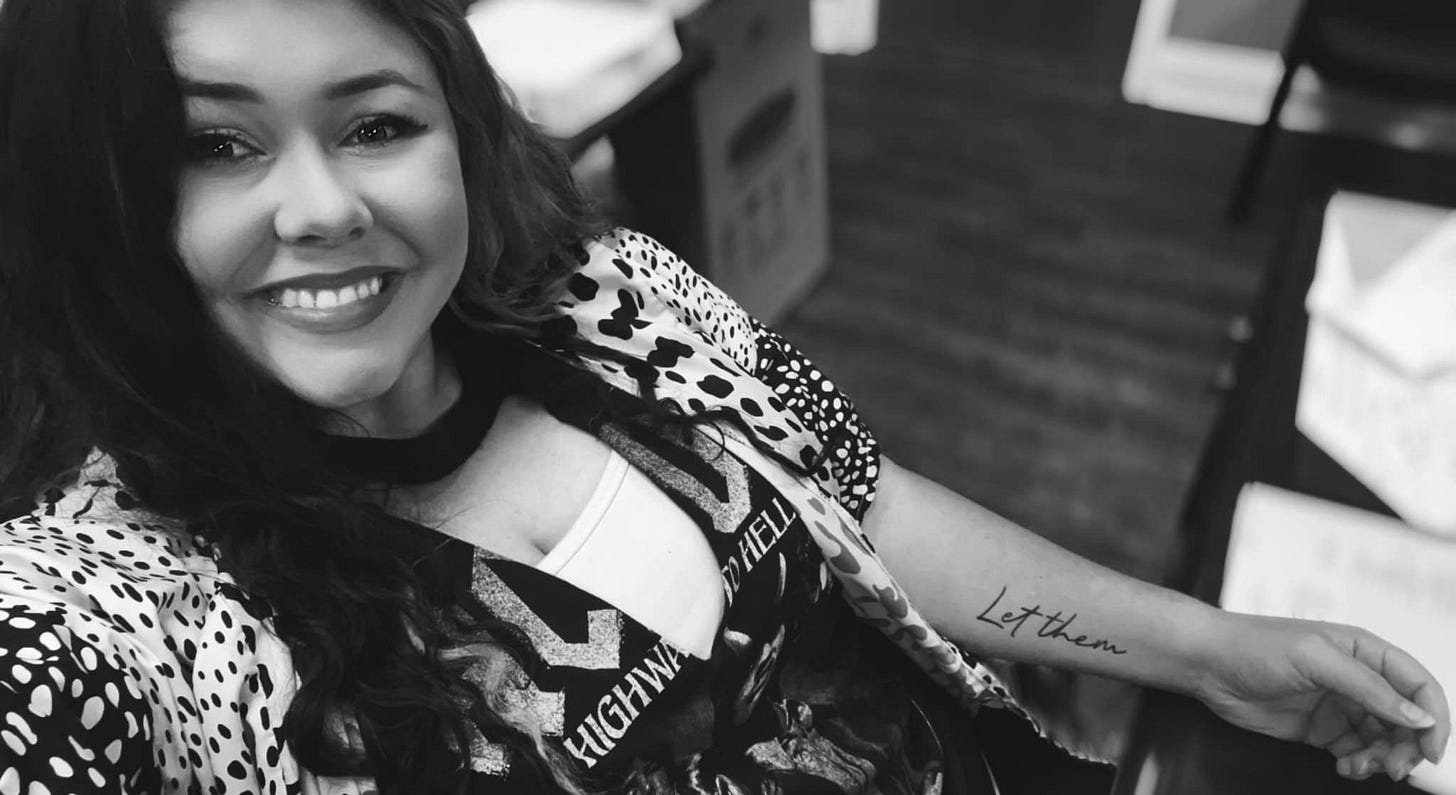
The parallels between these cases are striking:
Both involve established figures (Robbins/Bellamy) adapting content from creators with smaller but dedicated followings (Phillips/Maehashi)
Both feature similar defenses centered on the idea that concepts cannot be owned
Both showcase different attribution standards between communities – traditional publishing versus digital creation
Both resulted in social media becoming the primary venue for accountability when formal channels proved inadequate
Both cases ignited discussions about the economics of digital attribution, with smaller creators feeling economically disadvantaged when their work is repurposed without credit
The similarities suggest that what we're witnessing is not merely isolated incidents of potential plagiarism but systemic friction between different digital cultures with incompatible understandings of attribution and originality.
Anthropology in the Digital Field
What makes the Maehashi-Bellamy controversy particularly fascinating from an anthropological perspective isn't the question of attribution, but how it reveals distinct cultural frameworks emerging from seemingly overlapping digital spaces. This has been explored by anthropologist Clifford Geertz in his 1973 text The Interpretation of Cultures. Geertz wrote that “man is an animal suspended in webs of significance he himself has spun”. All communities spin their own intricate systems of meaning around concepts and their collective values.
These webs become temporarily visible when communities clash over how their values are represented. The recipe development and influencer communities inhabit overlapping digital territories yet have constructed entirely different standards for determining creative ownership, establishing authority, and defining ethical boundaries. Just as Geertz argued that understanding culture requires interpretive analysis rather than scientific law-seeking, understanding these digital attribution conflicts requires examining the interpretive frameworks each community employs rather than simply seeking universal standards of plagiarism.
Digital Spaces as Field Sites
The digital landscape, with its platform-specific architectures and affordances, creates natural boundaries between what might be considered different field sites in research anthropology. The Instagram Stories format Bellamy used for her response – ephemeral, visually focused, and resistant to external linking – perfectly embodies the values of influencer culture. Meanwhile, Maehashi's detailed blog post with its careful documentation, side-by-side comparisons, and preservation of evidence reflects the recipe development community's emphasis on verification and technical precision.
These digital spaces don't just host communication; they actively shape it. Instagram's architecture rewards personal narrative and visual impact, while blog formats with their search engine optimisation and permalink structures encourage detailed documentation and transparent attribution. When these communities attempt to engage across platform boundaries, they often find themselves speaking what amount to different languages despite using the same words – a classic problem of translation familiar to anthropologists studying intercultural communication.
Different Epistemologies of Attribution
What's particularly revealing is how each community has developed distinct ways of knowing what constitutes creative ownership. The recipe development community employs documented epistemology – knowledge claims about recipe development require verification through procedural documentation, testing notes, and clear lineage. This resembles academic citation practices, where authority stems from transparent documentation of influences.
In contrast, the influencer community operates through what we might term an embodied epistemology3 – knowledge claims about creative work are verified through personal narrative and temporal precedence rather than documented process. This parallels oral knowledge traditions, where authority often derives from personal experience and storytelling.
Neither system is inherently superior, but they operate with fundamentally different understandings of how creative authority is established. When Bellamy offers a bakery display photo from 2016 as evidence of recipe ownership, she's not merely providing weak evidence by recipe development standards; she's employing an entirely different system for establishing provenance – one that makes perfect sense within the cultural logic of influencer spaces.
Participant Observation in Digital Culture Clashes
As observers of this controversy, we find ourselves engaged in a form of digital participant observation – that core anthropological method where researchers immerse themselves in communities to understand their internal logic and cultural frameworks. What makes digital spaces unique is how they enable simultaneous participation across multiple communities.
Internet investigators examining recipe similarities aren't just gathering evidence; they're participating in an emerging cultural practice of digital verification that combines aspects of academic research, forensic investigation, and community moderation. Their collective efforts demonstrate how digital communities develop sophisticated internal mechanisms for establishing truth and navigating ethical boundaries even when formal systems prove inadequate.
These digital detectives are themselves performing a form of anthropology – documenting, analysing, and interpreting how different communities construct meaning around attribution. Their work reveals how the internet has created spaces where different cultural systems of value, evidence, and attribution interact, clash, and occasionally find translation.
Recipes for Recognition in a Digital Age
The Maehashi-Bellamy controversy offers more than just grist for the internet drama mill. It provides a compelling case study in accidental anthropology – how communities outside formal academic contexts naturally develop anthropological practices as they navigate complex (and sometimes foreign-to-them) cultural terrain. This case connects directly to themes I've explored in previous articles. In The Plague of Digital Forgetfulness, I examined how digital preservation often captures form without context; here, we witness this dynamic as screenshots of recipes retain their measurements whilst losing their development history4. Similarly, my exploration of classification systems in The Hidden Life of Books highlighted how categorisation reflects underlying values – just as the different attribution systems we've analysed here reflect the distinct values of recipe development versus influencer communities.
What makes these digital attribution conflicts particularly significant is how they reveal the evolving relationship between creativity, authentication, and platform architecture. The anthropological lens reveals something critical that legal frameworks often miss: these aren't merely disputes about who owns what, but fundamental collisions between different ways of understanding what creativity and attribution mean.
Perhaps most importantly, this analysis reminds us that digital ethics isn't simply a matter of establishing universal standards, but of developing cultural translation tools that help communities with different values communicate across increasingly fragmented digital landscapes.
In the end, the recipe for recognition in digital spaces may require ingredients from multiple cultural traditions – the procedural rigour of recipe development culture alongside the narrative depth of influencer communities – blended together through careful cultural translation. As accidental anthropologists navigating these digital territories, we're all participating in the creation of new ethical frameworks for a world where the boundaries between inspiration and appropriation are increasingly complex, contested, and consequential.
Just as the show-don't-tell edict transforms beyond creative writing, digital communities transform attribution practices beyond simple copying. The shadow narratives we construct – whether in public relations, social media posts, or recipe development – reveal more about our values than any explicit statement. And sometimes, as with those strikingly similar pink boxes with bold branding, the visual evidence speaks volumes without saying a word.
Pun intended. It is taking a force of will like no other to not include every single culinary pun I can think of.
A more vibes-based approach to use common influencer parlance.
If they ever had it.


A well thought out perspective, with more depth, when compared to mainstream media.